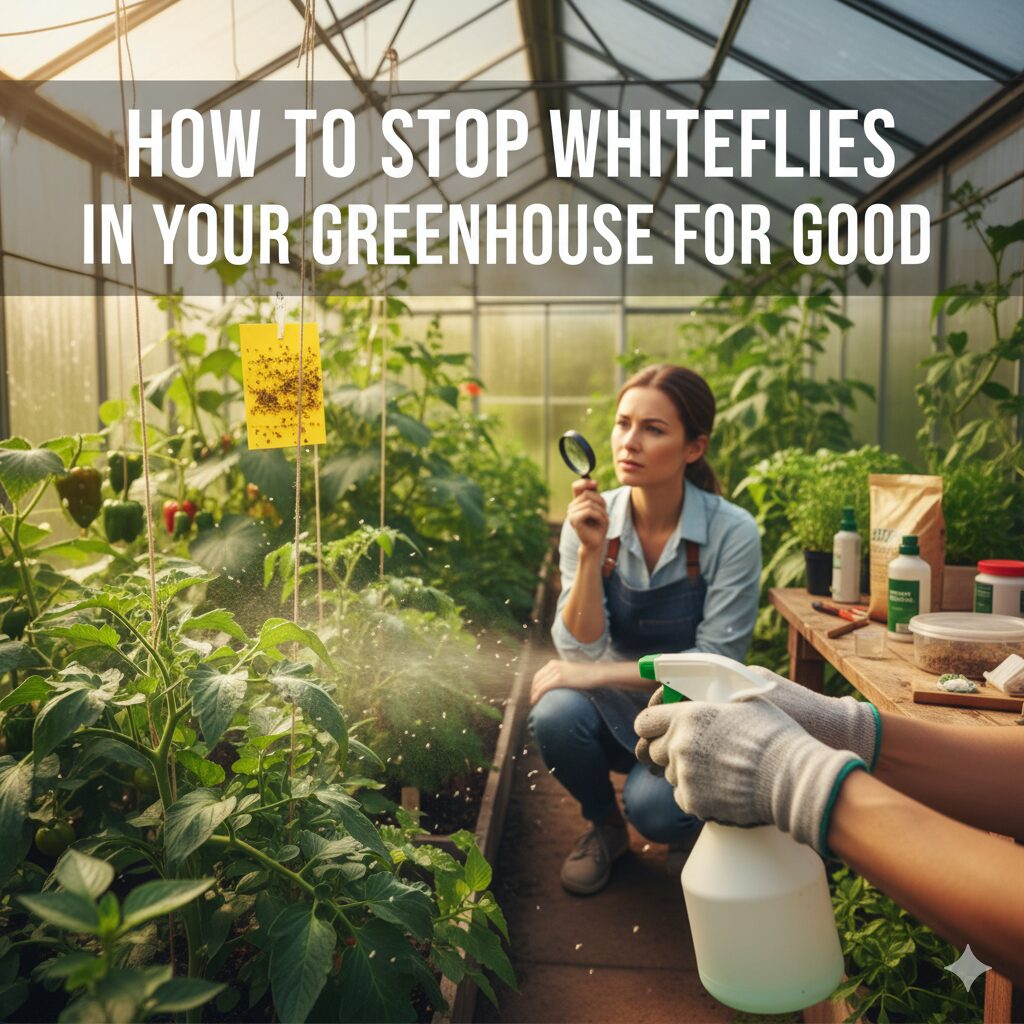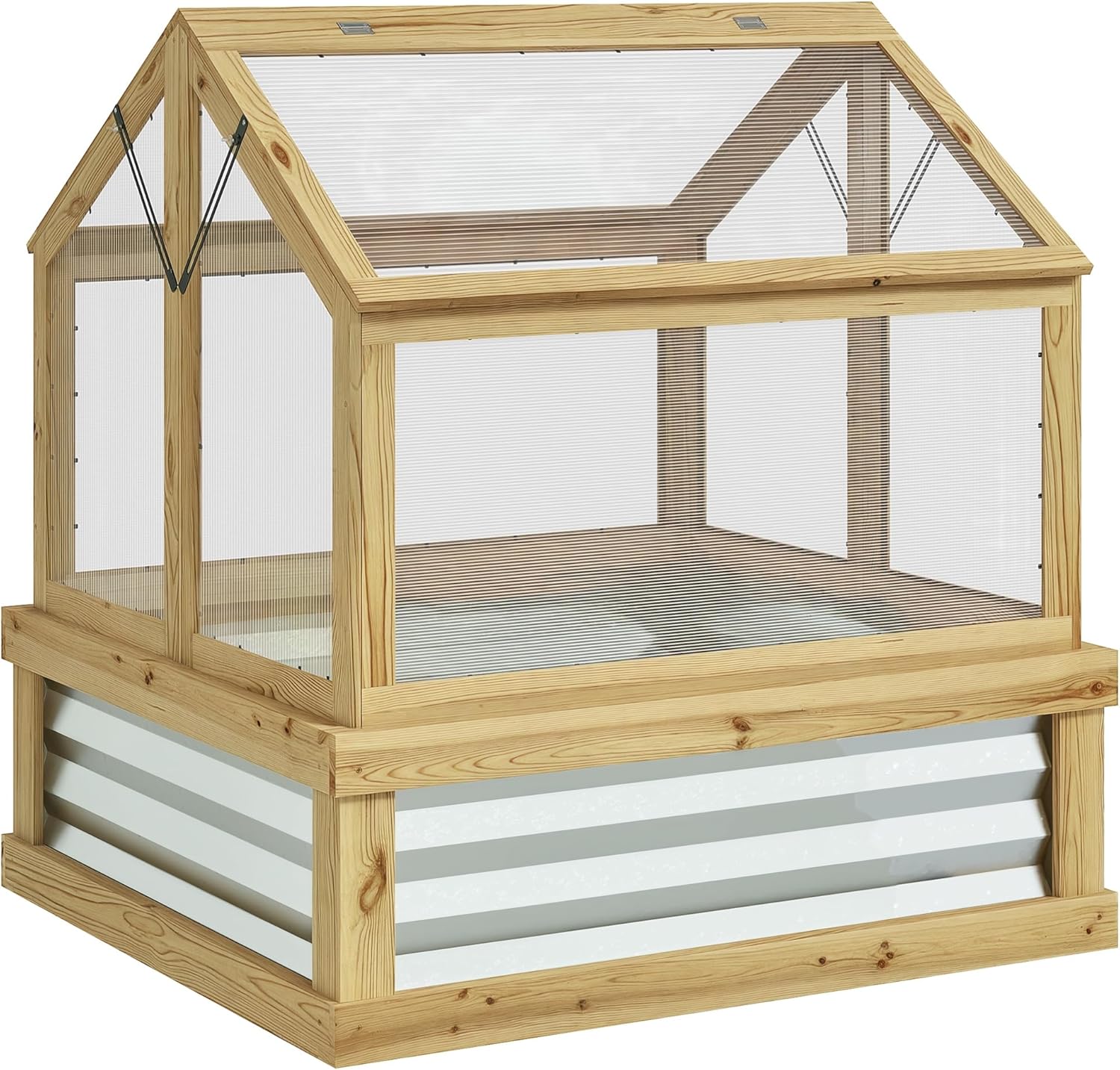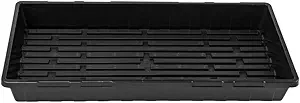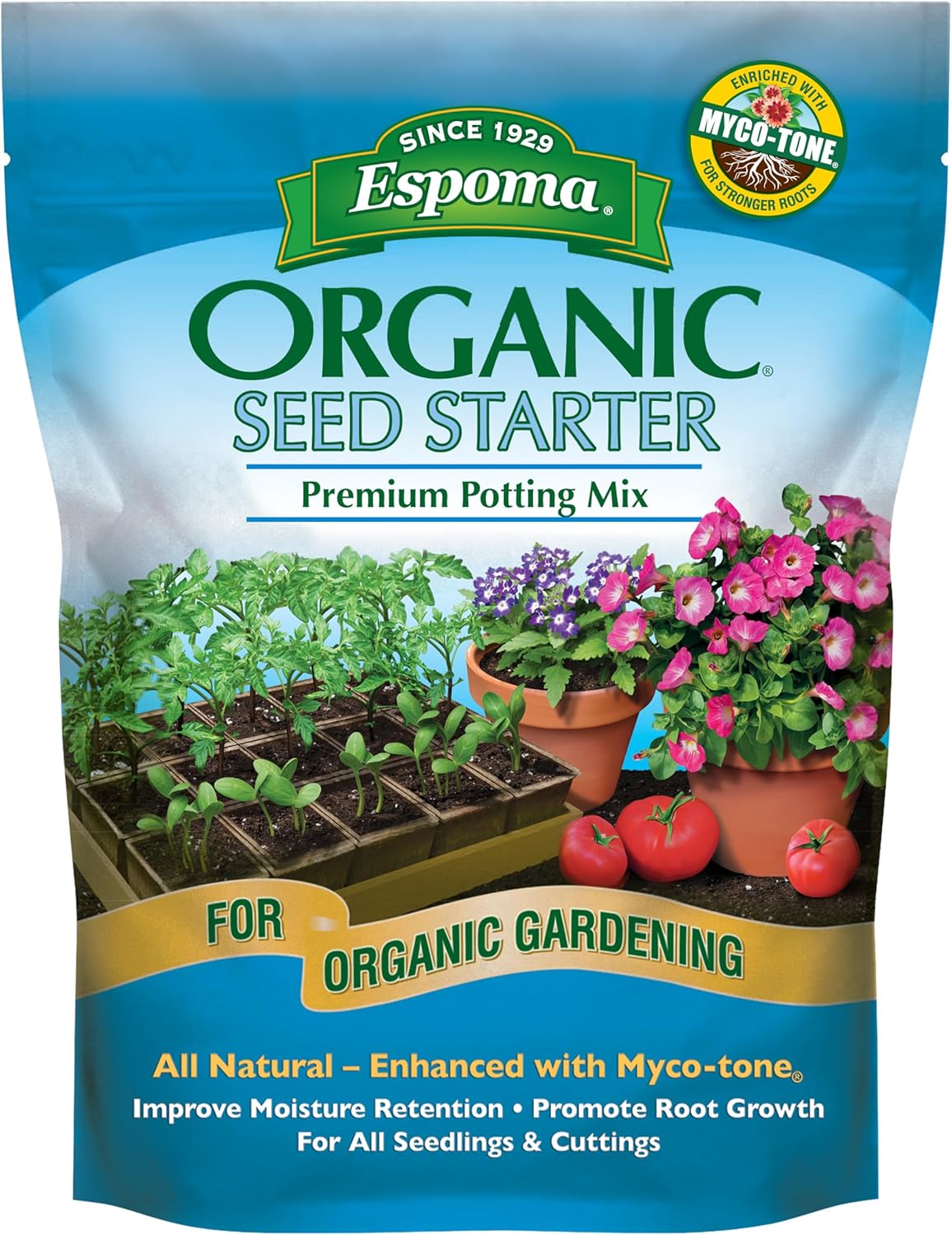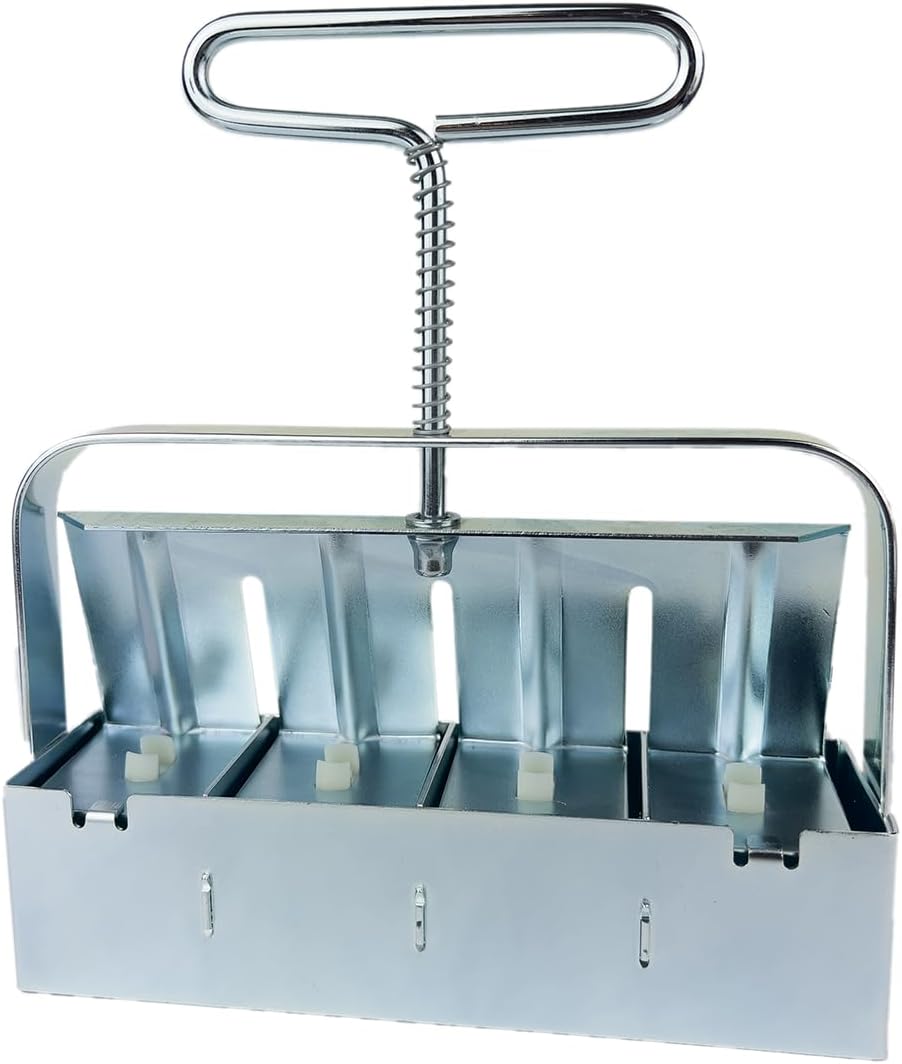Affiliate Disclosure: Our team is dedicated to helping you grow a pest-free garden. This post contains affiliate links. If you purchase products through our links, we may earn a commission at no extra cost to you. This supports our extensive research and hands-on testing. We only recommend products we trust to use in our own greenhouses.
The Ultimate IPM Guide: How to Stop Whiteflies in Your Greenhouse for Good
There are few sights more disheartening for a greenhouse gardener than brushing against a beautiful tomato or cucumber plant and seeing a sudden, ghostly cloud erupt into the air. That “snowstorm in July” is the tell-tale sign of a whitefly infestation, and it’s a problem that can go from a minor annoyance to a crop-destroying nightmare with terrifying speed. From our own hard-won experience, we know the feeling of panic that sets in as you realize these tiny, sap-sucking insects are multiplying faster than you can control them.
But here’s the good news: you can win this fight. The key is to stop thinking in terms of a single “magic bullet” spray and instead adopt a holistic, multi-layered strategy called Integrated Pest Management (IPM). IPM is a smart, sustainable approach used by professional growers that prioritizes prevention and uses the least toxic solutions first. This guide is our complete, field-tested IPM battle plan. We’ve poured years of research, trial, and error into this process. We’ll walk you through how to identify your enemy, how to build an iron-clad defense, and how to deploy a full arsenal of tools—from beneficial insects to organic sprays—to reclaim your greenhouse and keep it thriving.
Know Your Enemy: A Deep Dive into the Whitefly
Before you can defeat an enemy, you must understand it. Whiteflies are not true flies; they are more closely related to aphids and mealybugs. They are notorious pests in greenhouses because the warm, protected environment allows them to reproduce year-round at an astonishing rate.
How to Identify a Whitefly Infestation:
- The “White Cloud”: This is the most obvious sign. When you disturb an infested plant, a cloud of tiny, white, moth-like insects will fly up, circle around, and quickly resettle on the undersides of the leaves.
- Check Under the Leaves: Adult whiteflies, along with their eggs and immobile nymph stages, will be clustered on the undersides of leaves, especially near the top of the plant.
- Sticky “Honeydew”: Like aphids, whiteflies excrete a sticky, sugary substance called honeydew. You may notice shiny, sticky spots on leaves or the floor beneath heavily infested plants.
- Black “Sooty Mold”: This black, unsightly fungus grows on the honeydew. While it doesn’t directly harm the plant, it blocks light and reduces photosynthesis, weakening the plant over time.
- Yellowing & Stunted Growth: As whiteflies feed on plant sap, they drain the plant of vital nutrients. Heavy infestations will cause leaves to turn yellow, curl, and eventually drop, leading to stunted growth and reduced yields.
The Whitefly Lifecycle: Why They’re So Hard to Kill
A single female can lay hundreds of eggs in her short life. The lifecycle from egg to adult can be as fast as 3 weeks in warm conditions. The key thing to understand is that most sprays are only effective against the adult and early nymph stages. The eggs and the waxy, scale-like pupal stage are highly resistant. This is why a single spraying is never enough; you must be persistent to break the lifecycle.
The IPM Strategy: Your 4-Tiered Battle Plan
Integrated Pest Management is a pyramid. You start with the widest, most important layer at the bottom (Prevention) and only move up to the next tier when necessary. This approach is more effective, better for the environment, and creates a more resilient greenhouse ecosystem.
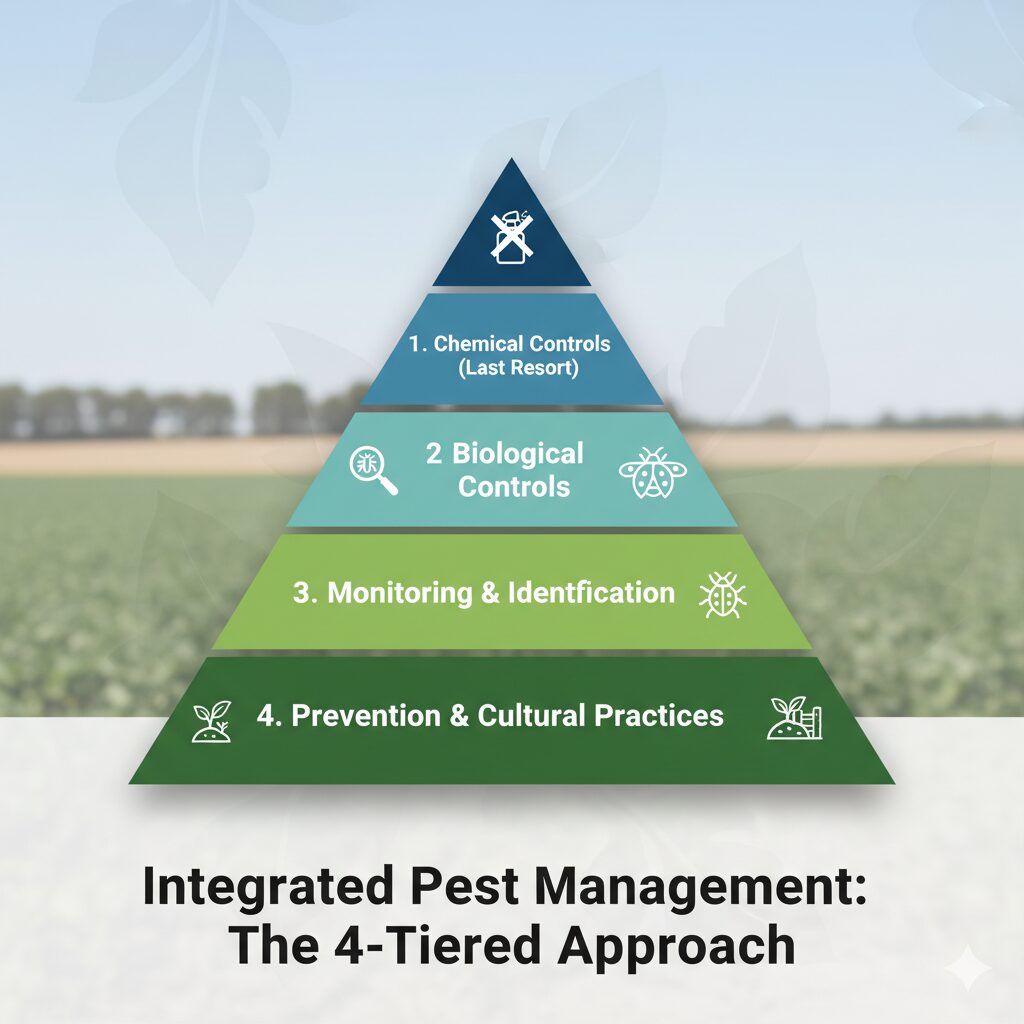
Tier 1: Prevention – Your First and Best Defense
The easiest whitefly infestation to deal with is the one that never starts. This is where most of your energy should be focused. A well-maintained, properly ventilated greenhouse is naturally resistant to pests.
Start with Clean Plants (Quarantine!)
The most common way whiteflies enter a clean greenhouse is as hitchhikers on new plants. Institute a strict quarantine protocol. Any new plant, whether from a nursery or a friend, should be isolated in a separate area for at least 2-3 weeks. Inspect it thoroughly for any signs of pests before introducing it to your main greenhouse population.
Sanitation is Non-Negotiable
A clean greenhouse leaves no place for pests to hide or overwinter. This means removing all weeds (a primary host for whiteflies) and dead plant debris promptly. At the end of each season, a full clean-out is essential. For a complete guide, follow our comprehensive greenhouse maintenance checklist, which covers everything you need to do to reset your space.
Optimize Airflow and Humidity
Whiteflies thrive in stagnant, humid air. Good air circulation is one of your most powerful preventative tools. It disrupts their flight and landing patterns and helps manage humidity. Making the right choice in the greenhouse fan vs vent debate is crucial; ideally, you should have both an exhaust fan for air exchange and horizontal airflow (HAF) fans to keep the air inside moving 24/7.
Tier 2: Monitoring & Physical Controls – The Hands-On Approach
This tier involves actively monitoring for pests and physically removing them before their numbers get out of control.
The Power of Yellow Sticky Traps
Whiteflies are naturally attracted to the color yellow. Yellow sticky traps are an indispensable tool for two purposes:
- Monitoring: Place a few traps around your greenhouse, especially near doors and vents. Check them weekly. The first appearance of a single whitefly on a trap is your early warning signal to start taking action.
- Mass Trapping: If you have an active (but still small) infestation, deploying a large number of traps (e.g., one every 2-3 feet) can significantly reduce the adult population.
Shop Yellow Sticky Traps on Amazon
Manual Removal
For small-scale infestations, direct action works. Put on some gloves and wipe down the undersides of leaves with a damp cloth to crush eggs and nymphs. You can also simply prune and remove the most heavily infested leaves. Dispose of them in a sealed bag far from the greenhouse.
The Handheld Vacuum Method
From our experience, this is one of the most satisfying and effective ways to quickly reduce the adult population. Get a small, cordless handheld vacuum. In the cool of the early morning when the insects are sluggish, simply vacuum them right off the undersides of the leaves. Afterward, empty the vacuum contents into a sealed bag and freeze it before disposal.
Tier 3: Biological Controls – Recruiting a Tiny Army
Why fight alone? Biological control involves releasing natural predators and parasites of whiteflies into your greenhouse. This is an incredibly effective, safe, and sustainable long-term solution.
*Encarsia formosa* – The Whitefly’s Worst Nightmare
*Encarsia formosa* is a tiny parasitic wasp (they don’t sting humans!) that is the number one biological control agent for greenhouse whiteflies. The female wasp lays her eggs inside the whitefly nymph. The wasp larva then consumes the nymph from the inside, killing it and turning the whitefly pupa black—a clear sign that your army is at work.
Shop for Encarsia formosa on Amazon
Other Beneficial Insects
- Predatory Mites (*Amblyseius swirskii*): These mites are voracious predators that feed on whitefly eggs and nymphs. They are a great companion to Encarsia.
- Lacewing Larvae: Often called “aphid lions,” these generalist predators will happily devour whitefly nymphs and other soft-bodied pests.
Important Note: If you plan to use beneficial insects, you cannot use broad-spectrum chemical pesticides, as this will kill your “good bugs” as well as the pests.
Tier 4: Chemical Controls – The Last Resort (Safest First)
If an infestation has gotten out of hand, you may need to intervene with sprays. Always start with the least toxic, “softest” options first. The key to success with these contact sprays is **thorough coverage**. You must spray the undersides of every leaf to make contact with the pests.
Insecticidal Soap
This is your first-line chemical defense. Insecticidal soaps are specifically formulated to dissolve the waxy outer cuticle of soft-bodied insects like whiteflies, causing them to dehydrate and die. They are effective only on contact and have no residual effect, making them very safe for vegetable gardens and when used in conjunction with biologicals (wait a day or two after spraying to release). **Do not use household dish soap**, which can strip the protective waxes from plant leaves and cause damage.
Shop Insecticidal Soap on Amazon
Neem Oil
Neem oil is a fantastic multi-purpose tool. It acts as a repellent, an anti-feedant, and a growth regulator that disrupts the insect’s lifecycle. It is most effective when used preventatively or on low-level infestations. It can also help control fungal diseases like powdery mildew.
Shop Neem Oil on Amazon
Safety First!
Always apply any spray in the early morning or evening to avoid burning plant leaves in direct sun. Wear protective gear like gloves and eyewear. Always read and follow the product label instructions. Test any new spray on a small section of a plant and wait 24 hours to ensure there is no adverse reaction before spraying your entire crop.
The Big Picture: A Healthy Greenhouse is a Pest-Free Greenhouse
Ultimately, getting rid of whiteflies is about creating an environment that favors your plants, not the pests. Your choice of best greenhouse covering, for example, impacts the light and heat, which in turn affects plant stress and pest pressure. The very structure of your greenhouse matters; a constant debate in the greenhouse plastic vs glass comparison is how well they seal, which impacts pest entry points. A healthy greenhouse is a complete ecosystem.
Frequently Asked Questions (FAQ)
Q1: What is the black, sticky stuff on my leaves?
A: The sticky substance is “honeydew,” the sugary excrement from the whiteflies. The black fungus that grows on it is called “sooty mold.” Sooty mold itself doesn’t feed on the plant, but it blocks sunlight. Wiping the leaves with a damp cloth with a bit of insecticidal soap can help remove it.
Q2: Can I use household dish soap instead of insecticidal soap?
A: We strongly advise against it. Household detergents are designed to strip grease and can damage the protective waxy coating on your plant’s leaves, leading to burning and dehydration. Specially formulated insecticidal soaps are made from potassium salts of fatty acids and are much safer for plants.
Q3: Will whiteflies survive a cold winter in my unheated greenhouse?
A: In many parts of the U.S., yes. While a hard freeze will kill the adults, the pupal stages of some whitefly species can survive on plant debris or weeds, ready to emerge in the spring. This is why a thorough autumn cleanup, as detailed in our maintenance checklist, is absolutely critical.
Final Thoughts: Consistency is Victory
Defeating a whitefly infestation is not a one-time event; it’s a campaign. It requires vigilance, persistence, and a multi-pronged strategy. By adopting an Integrated Pest Management approach, you move from a reactive state of panic to a proactive state of control. You build a resilient greenhouse ecosystem that is naturally resistant to pests. From our experience, the moment you see your beneficial insects at work or watch your whitefly population dwindle without resorting to harsh chemicals, you’ll know you’ve become a more effective and sustainable gardener.

